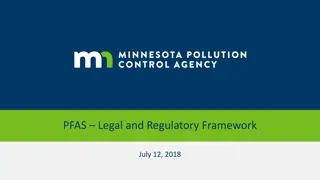Clinical Response to PFAS Exposure in the General Population
Exposure to PFAS (per- and polyfluoroalkyl substances) is prevalent among Americans, with pregnant women showing detectable levels. Screening for health effects of exposure includes assessing cholesterol, thyroid function, and other symptoms. There is no known safe level of PFAS exposure, and ordering PFC (perfluorinated chemicals) levels may lead to anxiety with no definitive treatment. Risk communication plays a crucial role in addressing fears and advising on risk reduction activities, emphasizing the importance of reducing or removing exposure, maintaining a healthy lifestyle, and following local guidelines. Effective communication strategies involve listening, acknowledging uncertainties, and providing resources for support.
Download Presentation

Please find below an Image/Link to download the presentation.
The content on the website is provided AS IS for your information and personal use only. It may not be sold, licensed, or shared on other websites without obtaining consent from the author.If you encounter any issues during the download, it is possible that the publisher has removed the file from their server.
You are allowed to download the files provided on this website for personal or commercial use, subject to the condition that they are used lawfully. All files are the property of their respective owners.
The content on the website is provided AS IS for your information and personal use only. It may not be sold, licensed, or shared on other websites without obtaining consent from the author.
E N D
Presentation Transcript
Clinical Response to PFAS Exposure Susan Buchanan, MD, MPH Great Lakes Center for Children s Environmental Health Region 5 Pediatric Environmental Health Specialty Unit University of Illinois at Chicago School of Public Health
Acknowledgement: The U.S. Environmental Protection Agency (EPA) supports the PEHSU by providing partial funding to ATSDR under Inter- Agency Agreement number DW-75-95877701-4. Neither EPA nor ATSDR endorse the purchase of any commercial products or services mentioned in PEHSU publications
Exposure to PFAS in the general population National Report on Human Exposure to Environmental Chemicals CDC 2017 The vast majority of Americans have detectable levels of PFAS Environmental chemicals in pregnant women in the United States: NHANES 2003-2004. Woodruff TJ, Zota AR, Schwartz JM. Environ Health Perspect. 2011 Jun;119(6):878-85 163 chemicals, 268 pregnant women Certain polychlorinated biphenyls, organochlorine pesticides, PFCs, phenols, PBDEs, phthalates, polycyclic aromatic hydrocarbons, and perchlorate were detected in 99-100% of pregnant women.
Should I order PFC levels on my exposed patients? NO No known safe or unsafe levels No treatment for elevated levels Levels cannot predict health outcome Levels may be due to multiple exposure sources Increased anxiety, dread, desire for additional testing
Screening for health effects of exposure Elevated cholesterol fasting lipid panel Hyper/hypo-thyroidism TSH Ulcerative cholitis symptom history Testicular CA symptom history, PE, teach STE Kidney CA symptom history, urine/abd exam? PIH/preclampsia routine BP, urine dip
Risk Communication External hazards FEAR, LACK OF CONTROL Scientific facts play less of a role in perception of risk than beliefs, values, and experiences
Communication LISTEN and empathize Be clear about acknowledging uncertainty and unknowns Advise about risk reduction activities: Reduce/Remove from exposure Healthy lifestyle Routine primary health care Follow local fish advisories Offer resources
Risk communication For exposures at the reference level of a chemical the chances are 1:1,000,000 The chances are very low that you will have health consequences from this exposure. Benefits and risks should be weighed, e.g. breastfeeding Give the patient some control back: Ask for their participation in the risk management response: What actions do you think you can take to lower your exposure and your risk of health outcomes?
Patient questions My water is contaminated. Will you please order a blood level? My blood level is high. What should I do? I live in a contaminated area. Can I breastfeed my baby?
Patient questions Can we bathe in contaminated water? This is really stressing me out. What can I do? I m afraid I m going to get cancer. Can you check me for it? I want to get pregnant but now I m worried. Should I postpone pregnancy?
Resources Additional Information Resource Link ATSDR: PFAS portal http://www.atsdr.cdc.gov/pfc/index.html http://www.c8sciencepanel.org/prob_link.html http://www.c8sciencepanel.org/publications.html C8 Science Panel https://www.epa.gov/chemical-research/research-perfluorooctanoic-acid- pfoa-and-other-perfluorinated-chemicals-pfcs http://www.iarc.fr/ EPA: PFAS IARC NIEHS: PFAS https://www.niehs.nih.gov/health/materials/perflourinated_chemicals_50 8.pdf http://www.pehsu.net/ Pediatric Environmental Health Specialty Units (PEHSU)
Resources Who to call? More information about PFAS: Information about PFAS contamination in Michigan:
Pediatric Environmental Health Specialty Units (PEHSU) Funded by federal EPA, ATSDR Staffed by: Occupational/Enviro Med Peds or Family Med Medical toxicologists Pediatric health nurses Industrial hygienists
Great Lakes Center for Childrens Environmental Health Region 5 PEHSU (312) 864-5526 or (866) 967-7337 Michigan Poison Control: (800) 222-1222























